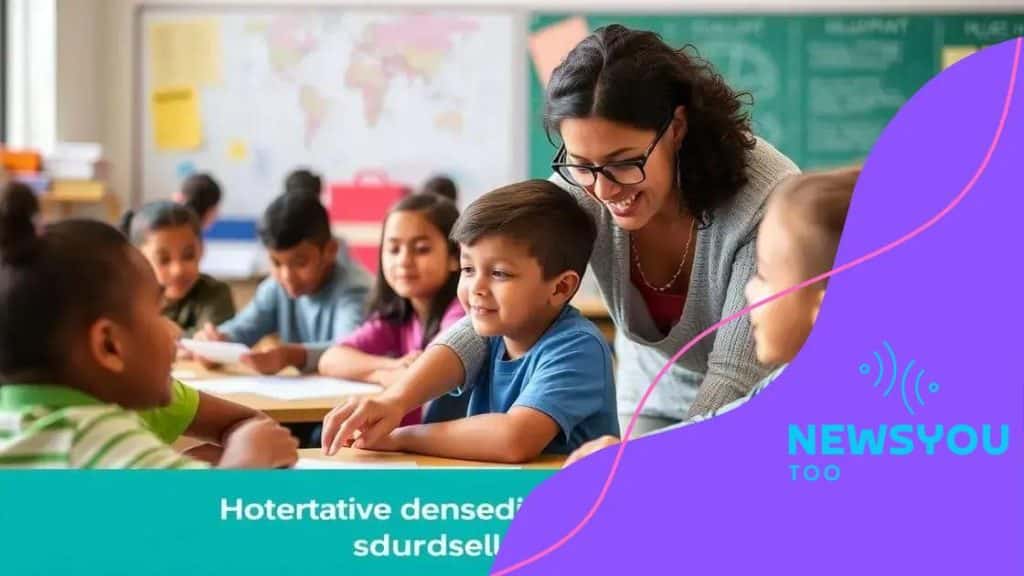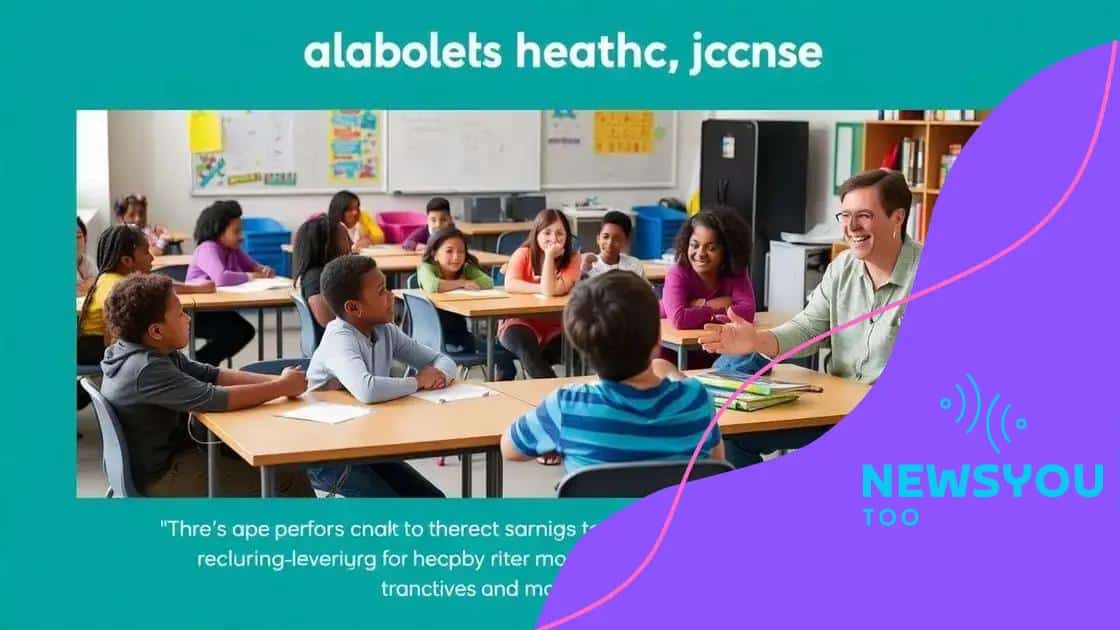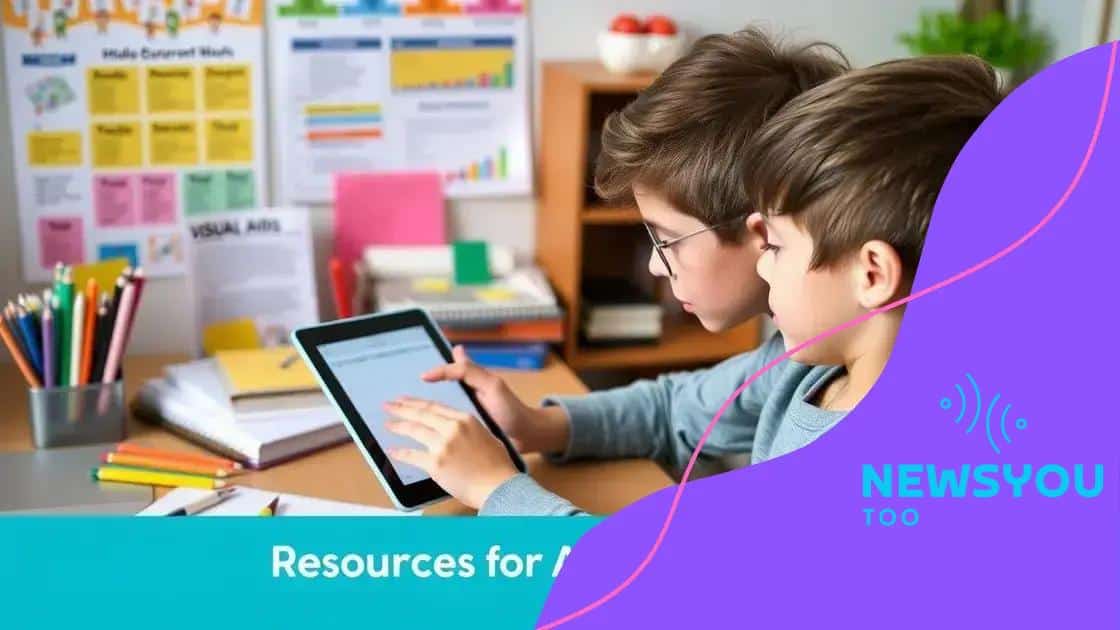How to support students with ADHD in the classroom

Anúncios
To support students with ADHD in the classroom, implement individualized instruction, create an inclusive environment, utilize effective teaching strategies, and engage parents and caregivers in the learning process.
How to support students with ADHD in the classroom is a question many educators grapple with. By implementing specific strategies, you can make a significant difference in their academic journey. Have you considered how small changes can lead to better engagement?
Anúncios
Understanding ADHD: Key Characteristics
To effectively support students with ADHD, it is essential to first understand the key characteristics of this condition. ADHD stands for Attention Deficit Hyperactivity Disorder, and it impacts how individuals focus, act, and navigate social situations. By recognizing these traits, educators can adapt their teaching methods accordingly.
Common Characteristics of ADHD
Students with ADHD may exhibit several common traits that can affect their learning environment. It is crucial to identify them early on to offer appropriate support.
- Inattention: Difficulty sustaining attention, following instructions, and organizing tasks.
- Impulsivity: Acting without thinking, which can lead to disruptive behavior.
- Hyperactivity: Excessive movement and difficulty staying seated, often restless.
- Difficulty with time management: Struggling to meet deadlines and manage schedules.
Understanding these traits can help educators implement strategies to guide students effectively. For instance, noticing the signs of inattention can lead teachers to provide clearer instructions and more interactive activities.
Anúncios
It’s also important to create a classroom environment that alleviates distractions. Consider seating arrangements that minimize disturbances. Additionally, using visual aids can help maintain student focus on tasks.
How ADHD Affects Learning
Recognizing how ADHD affects a child’s learning process is vital for educators. Students with ADHD often struggle to grasp and remember lessons due to their inattention. Therefore, lessons should be concise and engaging. Integrating movement or hands-on activities can enhance learning experiences for these students.
To further accommodate these students, incorporating routine breaks can be beneficial. This allows them to recharge and refocus their energy. While there are challenges, understanding students’ needs helps to establish a more supportive and productive classroom.
Ultimately, being aware of ADHD characteristics is the first step in creating an inclusive learning environment. By equipping themselves with this knowledge, educators can tailor their approaches and support all students effectively.
Creating an Inclusive Classroom Environment

Creating an inclusive classroom environment is essential for supporting all students, especially those with ADHD. By fostering a space where every learner feels valued and engaged, educators can enhance the overall learning experience.
Key Elements of an Inclusive Classroom
An inclusive classroom relies on several key elements that promote a sense of belonging. These aspects enable students to thrive together.
- Flexible Seating: Arranging the classroom to allow for movement can help students with ADHD feel more comfortable. Consider options like bean bags, standing desks, or floor cushions.
- Clear Expectations: Setting clear rules and expectations lets students know what to anticipate. Visual charts can act as reminders and help with transitions.
- Diverse Learning Materials: Incorporating different types of learning materials, such as books, videos, and hands-on activities, caters to various learning styles and keeps students engaged.
- Supportive Relationships: Building strong bonds with students fosters trust. Attention to individual interests can strengthen these connections.
Additionally, implementing visual schedules can aid in maintaining structure throughout the day. When students know what to expect, they may feel more centered and ready to learn.
Classroom rules should be consistent but also adaptable to meet the needs of all students. Incorporating students in setting classroom norms can increase their investment in maintaining a positive environment.
Strategies for Inclusivity
Utilizing various strategies can further enhance inclusivity. Small group activities enable students to collaborate while receiving individual attention from the teacher. Additionally, allowing for movement breaks during lessons can help students with ADHD release pent-up energy.
Technology can also play a role in fostering an inclusive environment. Tools like interactive whiteboards and educational apps can engage students and provide personalized learning experiences.
Through these approaches, educators can create a vibrant and inclusive classroom that supports diverse learning needs. This not only benefits students with ADHD but enriches the learning environment for all.
Effective Teaching Strategies for ADHD Students
Effective teaching strategies for students with ADHD can significantly improve their learning and engagement in the classroom. By implementing tailored methods, educators can help these students thrive while addressing their unique challenges.
Individualized Instruction
Every student with ADHD has different needs. Therefore, individualized instruction is key to reaching them effectively. Teachers can take time to understand each student’s strengths and weaknesses to design lessons that cater specifically to those needs.
- Use frequent check-ins: Regularly assessing understanding helps adjust teaching methods promptly.
- Break tasks into smaller steps: This makes complex assignments more manageable.
- Provide immediate feedback: Quick responses can reinforce learning and keep students engaged.
- Incorporate interests: Integrating personal interests into lessons can motivate students to participate actively.
Additionally, creating a structured environment has proven beneficial for students with ADHD. Establishing consistent routines and clear expectations helps students understand what is needed of them.
Interactive Learning
Interactive and hands-on activities can also enhance learning experiences for students with ADHD. These methods keep students actively engaged and reduce restlessness.
Examples of interactive learning include:
- Group projects: Collaborating with peers provides social interaction and support.
- Use of technology: Educational apps and games can make learning more engaging and tailored to individual learning speeds.
- Incorporating movement: Activities that involve physical movement can help channel surplus energy positively.
Moreover, integrating movement breaks during class can help recharge students’ focus. Short, active sessions allow students to reset and return to their learning tasks with renewed energy.
By consistently applying these strategies, teachers can create a more inclusive and supportive environment that caters to the diverse needs of students with ADHD. This tailored approach not only benefits students with ADHD but also enriches the learning atmosphere for all students.
Tools and Resources to Aid ADHD Learning

Tools and resources to aid ADHD learning play a crucial role in helping students succeed academically. Utilizing the right resources can make learning more accessible and engaging.
Assistive Technology
Modern technology offers a variety of tools designed specifically for students with ADHD. These tools can enhance focus and organization.
- Digital planners: These help students keep track of assignments and deadlines in an organized manner.
- Note-taking apps: Applications that allow audio recordings or visual notes can aid students in retaining information.
- Timers and alert apps: Tools that remind students when to take breaks can help manage time effectively.
- Interactive learning platforms: Websites and apps that make learning fun can keep ADHD students engaged.
Among these tools, digital planners are particularly beneficial. They allow students to visualize their tasks, breaking down assignments into manageable sections. This not only simplifies their workload but also helps them track their progress.
Study Strategies
In addition to technology, different study strategies can effectively aid learning for students with ADHD. Creating a routine that incorporates movement and varied activities can be beneficial.
- Chunking information: Dividing information into smaller bits makes it easier to digest.
- Using visuals: Charts, diagrams, and colors can enhance understanding and memory retention.
- Incorporating games: Educational games related to the subject matter can reinforce learning through play.
Effective study environments are also essential. A quiet, organized space free from distractions can significantly improve concentration. Gradually introducing study breaks can help sustain focus, allowing students to recharge before returning to their tasks.
By integrating these tools and strategies into their daily routines, students with ADHD can experience a more tailored learning journey. Ultimately, these resources can make a profound difference in their educational success.
Engaging Parents and Caregivers in Support
Engaging parents and caregivers in support of students with ADHD is essential for fostering a collaborative learning environment. When families are involved, students tend to perform better academically and socially.
Building Effective Communication
Open lines of communication between teachers and parents can make a significant difference in a child’s education. Regular updates on a student’s progress can help caregivers understand their needs and challenges.
- Frequent check-ins: Schedule regular meetings or phone calls to discuss the student’s progress and any concerns.
- Utilize technology: Send emails or use communication apps to keep parents informed about classroom activities and important dates.
- Provide resources: Share articles, websites, or workshops that can help parents understand ADHD better.
This two-way communication can build trust and foster an open dialogue about the best ways to support each student. Teachers can encourage parents to share any observations they have at home that might be useful in the classroom.
Involving Parents in the Learning Process
Parents and caregivers can play an active role in the learning process, contributing positively to students’ education. Involvement can take many forms.
- Participation in school events: Encourage parents to attend workshops, meetings, or events focused on ADHD and learning.
- Home-based support: Share strategies with parents that they can use at home to reinforce what is taught in class.
- Volunteer opportunities: Invite parents to help in the classroom or during school activities, fostering a sense of community.
Additionally, establishing a parent support group can provide a platform for caregivers to share experiences and strategies, creating a network of support. This group can invite guest speakers to discuss relevant topics, enriching the learning experience for everyone involved.
By actively engaging parents and caregivers, educators create a supportive home-school partnership that directly benefits students with ADHD and enhances their overall educational experience.
In conclusion, supporting students with **ADHD** requires a comprehensive approach that includes understanding their unique needs, creating inclusive classroom environments, applying effective teaching strategies, utilizing helpful tools and resources, and engaging parents and caregivers. When educators, families, and communities work together, they can create a nurturing atmosphere that promotes success for all learners. By implementing these strategies, we can pave the way for students with ADHD to reach their full potential and thrive academically and socially.
FAQ – Supporting Students with ADHD in the Classroom
What are some key characteristics of ADHD?
Students with ADHD often struggle with inattention, impulsivity, and hyperactivity, which can affect their learning and social interactions.
How can I create an inclusive classroom for students with ADHD?
You can create an inclusive classroom by using flexible seating, providing clear expectations, and incorporating diverse learning materials.
What teaching strategies work best for ADHD students?
Effective strategies include individualized instruction, interactive learning activities, and providing immediate feedback to keep students engaged.
How can parents support their children with ADHD?
Parents can support their children by maintaining open communication with teachers, facilitating home study strategies, and participating in school events.





